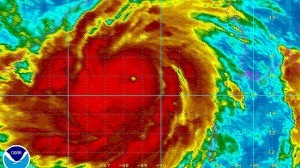According to catastrophe modeling firm AIR Worldwide, around 21:15 local time (15:45 UTC) on Saturday, October 12, very severe Cyclonic Storm Phailin made landfall on the eastern coast of India near Gopalpur in Odisha. Phailin was a large storm, with gale force winds (>63 km/h) extending 250 km on either side and storm force winds (>93 km/h) extending 100 km on either side. Results of simulations of Phailin using the AIR Tropical Cyclone Model for India indicate that insured wind losses to onshore properties in India (buildings, contents) will not exceed $150 million.

Phailin arrived as a Category 4 storm with maximum sustained 3-minute winds of 200–210 km/h at landfall, according to the Indian Meteorological Department (IMD). Phailin’s high winds and heavy rain—up to 300 millimeters in some regions—flooded roads, uprooted trees, damaged crops, cut off electricity, and destroyed thousands of poorly constructed homes. According to reports, Phailin brought a storm surge of more than 3.5 meters (11 feet) to portions of the coast.
“Phailin made landfall near Brahmapur about 160 km farther south than the Orissa Super Cyclone in 1999,” said Dr. Peter Sousounis, senior principal scientist, AIR Worldwide. “In this region, the continental shelf is steeper and overland terrain is higher, which combined to mitigate storm surge flooding.”
Inland flooding remains a concern. Heavy rainfall triggered flooding in Balasore, Mayurbhanj, Jajpur, and Bhadrak, leaving a large number of people stranded. The storm’s remnants are currently located close to southwest Daltonganj, in Jharkhand state, to the north of Odisha. The system is moving to the north-northwest and will continue to weaken gradually into a low pressure area.
According to AIR, India has a diverse commercial/industrial building stock, which continues to change as older structures are replaced with ones that are engineered for wind and water resistance. Commercial and industrial buildings are generally more resistant to wind and water damage than residential buildings.
According to AIR, most buildings are of masonry or concrete construction. Concrete construction is less vulnerable to flood than steel or masonry. Commercial and apartment buildings usually have stronger foundations than residential buildings, and are thus better able to resist flood loads.
The flooding is also expected to take its toll on agriculture. It has been estimated that as much as 600,000 hectares of the state’s rice area has also been impacted. While crop insurance is offered for many crops, participation remains relatively low because challenges remain in the pricing and administration of insurance products and in effective risk diversification.
Dr. Sousounis concluded, “Cyclone Phailin is the strongest cyclone to hit India in 14 years. While damage is anticipated to crops and residential properties, a high proportion of residential losses in the region are not insured. Insurance coverage in the affected area varies by line of business; overall take-up rates (insurance penetration) in the hardest hit regions are low.”
Before the storm arrived, India conducted its largest storm evacuation ever, relocating more than 900,000 people from the coast to shelters in schools and government offices. This large-scale evacuation effort is being credited for the low death toll, which currently stands at 25.
Source: AIR Worldwide
Was this article valuable?
Here are more articles you may enjoy.

 How Three New CMS Policies Impact Workers’ Comp Claims
How Three New CMS Policies Impact Workers’ Comp Claims  California Again Delays Wildfire Protection Rules for Homes
California Again Delays Wildfire Protection Rules for Homes  ‘Dream Is in Sight:’ Chamber, Reinsurers, Insurers Urge Florida to Stay the Course
‘Dream Is in Sight:’ Chamber, Reinsurers, Insurers Urge Florida to Stay the Course  NYT, Chicago Tribune Sue Perplexity AI as Copyright War Rages On
NYT, Chicago Tribune Sue Perplexity AI as Copyright War Rages On 